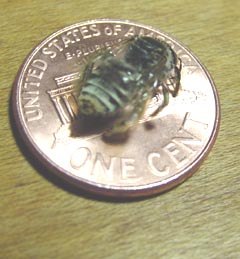
Each of the small brown mounds in the banner photo above (the undisturbed spaces are more grayish in color) marks the location of a single nest made by a female cactus bee.
Saguaro Cactus Bee (Diadasia opuntiae)
Main sources: O'Toole, Christopher & Anthony Raw, 1991, Bees of the World, London: Blandford; Batra, Suzanne, 1984, "Solitary Bees", Scientific American 250:2:120-27; "Cactus Bees", Desert Discovery (thanks to Dr. Katrina Mangin & Margrit McIntosh); The Bee Works (thanks to Dr. Stephen Buchmann, and to him as well for description of Diadasia spp below)
Cactus Bees are solitary, ground-nesting bees that specialize on the flowers of various kinds of cacti. There are some 23 species of Cactus Bees in the U.S. Southwest, and they serve as major pollinators of these plants.
Each Cactus Bee female constructs her own nest in the ground (the mud-dauber-wasp heritage), making a hole within which some 10-12 cells are provided, each with its own lump of pollen mixed with nectar. She then lays an egg in the cell, seals it, and -- after sealing up the whole nest -- departs and dies soon thereafter. The two images just below show the major external features of our Cactus Bee settlement: on the right, the various mounds, or "tumuli"; on the left, one of the mud "turret" entrances, which are composed of secretions from the bees' abdominal glands. Click on the right-hand image to enlarge it -- you can count at least six turret holes in this enhanced image.


In Saguaro-Juniper territory, we chanced upon the "Bee Village" illustrated above on June 10, 2002, walking across an apparently unoccupied terrace overlooking Hot Springs Canyon. Noticing the oddly disturbed Quiburis-clay surface -- more than 600 square feet filled with myriad little freshly-made mounds (see for example the banner photo at the top), we also noticed the swirling presence of considerable numbers of very small bees (see below, right), who were flying into and out of the many mud-turret entrances associated with the mounds (above, left). A quick-and-dirty estimate of both the size of the area and the number of visible holes per square foot led us to guess that perhaps 5,000 bees were involved, but the number might well be twice that (or more).
We contacted Dr Stephen Buchmann, a research entomologist associated with the Arizona-Sonora Desert Museum, the A.M.N.H., and the University of Arizona and who is an expert on Bees (see his website, The Bee Works), and who informed us that our newly-found village is one of Cactus Bees, most probably Diadasia opuntiae since they have been frequenting the Saguaro Cactus blossoms which have been opening at the time (the "opuntia" species label is a misnomer).
Diadasia species (below with penny for scale) are very common native Sonoran Desert bees, who make their living entirely from cactus pollen and nectar. Each female digs a nest about 12-25 cm deep, and provides a dozen or more cells into which an egg each is laid (see the more generic diagram in the page on Solitary Bees.

This photo (below) shows more clearly the pollen-catching leg hairs (scopa) of this kind of bee, which serve to transport pollen from one flower to another.
Click on image below to enlarge!

Cactus Bees should hatch out en masse, in 14-16 days after the above action stops. According to Dr. Buchmann, this is the fastest journey from egg to adult of any bee known. Our bee village, however, did not follow this calendar, at least not to our knowledge. Though we watched periodically, we never saw the emergence of the bees. Dr. Buchmann also said that hatching-out activities should last for 2-3 weeks, so the fact that our monitoring was several days apart should not have been a factor. During the first half of July we saw no bees, but occasional "Velvet Ants" (parasitic wasps) poking about the nest sites, as below:

Returning in late August, it was as if there had never been a bee village at this site. A mystery -- we may have missed the time-window of the hatching.
Return to Saguaro-Juniper Bees